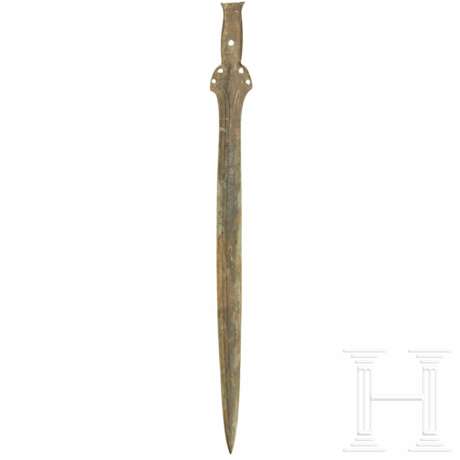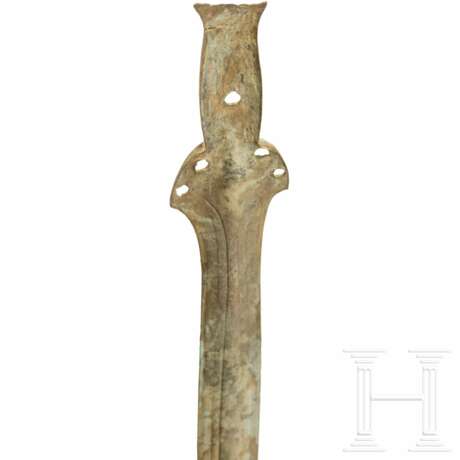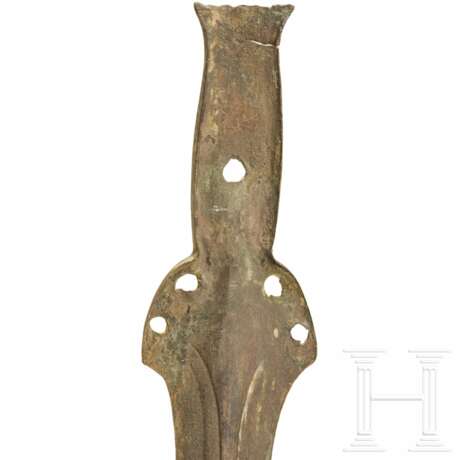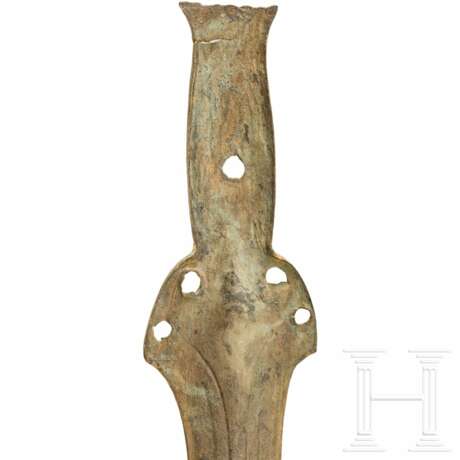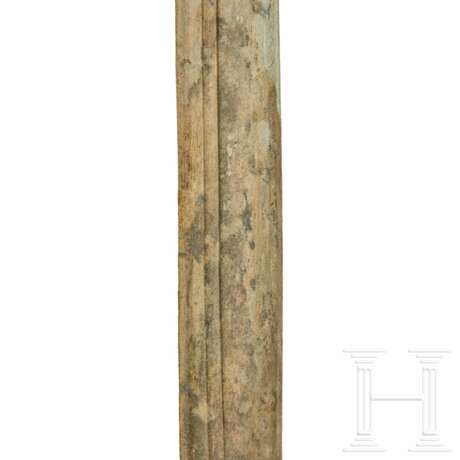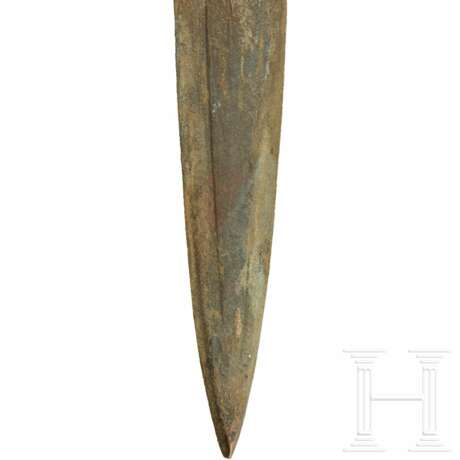ID 1416441
Lot 4089 | Griffzungenschwert vom Typ Reutlingen, späte Bronzezeit (Stufe D), 13. Jhdt. v. Chr.
51 cm langes Griffzungenschwert mit leicht gebauchter Griffzunge und breitem, leicht gebogenem Heft mit schwach gebogenen, fallenden Schultern und Löchern für vier Pflocknieten, zwei auf jeder Seite. Griffzunge und Heft mit scharfkantigen Randleisten versehen, die am oberen Ende der Griffzunge fischschwanzförmig ausbiegen. Der obere Abschluss nahezu horizontal. In der Mitte der Griffzunge ein Nietloch. Die im Querschnitt linsenförmige Klinge besitzt eine getreppte Mittelwulst, die deutlich von den Fasen abgesetzt ist. Die Kanten der "Treppung" schwingen auf dem Heft nach außen zum unteren Nietloch hin aus. Die Klinge mit nur annähernd parallelen Schneiden ist unterhalb des Hefts leicht eingezogen und mittig leicht gebaucht, ohne wie Schwerter vom Typ Hemigkofen eine deutliche Verbreiterung der Klinge mit Schwerpunkt im unteren Drittel zu besitzen. Es ist deshalb der Akzent auf einen Gebrauch als Stichwaffe gesetzt.
Abgesehen von einem schon antiken Riss am oberen Ende der Griffzunge bis zur Mitte derselben hin exzellent erhaltenes Exemplar ohne Scharten an den Schneiden. Die nur mit einer leichten Tönung versehene, minimal fleckige Oberfläche lässt den metallischen Untergrund vollflächig durchschimmern, was auf einen ehemaligen Flussfund hinweist. Die Form von Griffzunge, Heft und Klinge lässt das Schwert am ehesten dem Typ Reutlingen zuweisen. Typisch sind die vier Nietlöcher im Heft, während die Griffzunge in der Regel drei bis vier Nietlöcher besitzt. Mit 51 cm Länge liegt das Schwert am unteren Spektrum der bekannten Längen. Es bestehen Ähnlichkeiten zum italienischen Typ "Montegiorgio".
Ausgesprochen schönes und ausgezeichnet erhaltenes Exemplar eines spätbronzezeitlichen Griffzungenschwerts.
Provenienz: Süddeutscher Privatbesitz (nachgelassen), übernommen aus einer Spezialsammlung mit Schwerpunkt auf Stichwaffen, erworben in den 1960er bis 1970er Jahren im Kunsthandel.
A Reutlingen-type leaf blade sword, late Bronze Age (period D), 13th century B.C.
A Reutlingen-type leaf blade sword, late Bronze Age (period D), 13th century B.C.
51 cm leaf blade sword with a slightly bulbous tang and broad, slightly curved hilt with gently curved, plunging shoulders and perforations for four plug rivets, two on each side. The tang and hilt edged with sharp strips, which fan out in a fishtail at the top of the tang. The upper edge almost horizontal. A rivet hole in the centre of the tang. The blade of lenticular cross-section with a stepped, central rib, which is clearly offset from the bevelled edges. The edges of the "steps" flare outwards on the hilt towards the lower rivet hole. The cutting edges only roughly parallel, the blade is slightly constricted below the hilt and somewhat bulbous in the middle, without the distinct widening of the blade with a focus in the lower third, like Hemigkofen-type swords. The emphasis is therefore on its use as a thrusting weapon.
With the exception of an ancient crack from the upper end to the middle of the tang, an excellently preserved sword with no notches on the cutting edges. The surface is only lightly hued and minimally spotted, allowing the metallic base to shine through fully, which suggests it was originally found in a river. Given the shape of the tang, hilt and blade, the sword can most likely be assigned to the Reutlingen type. The four rivet holes in the hilt are characteristic, while the tang typically has three to four rivet holes. At 51 cm, the sword is at the lower end of the range of known lengths. There are similarities to the Italian "Montegiorgio" type.
Exceptionally superb example of a late Bronze Age leaf blade sword in fine condition.
Provenance: Private South German collection (bequeathed), inherited from a special collection with a focus on edged weapons, acquired in the art trade during the 1960s to 1970s.
Condition: I - II
| Auction house category: | European Stone and Bronze Age |
|---|
| Auction house category: | European Stone and Bronze Age |
|---|
| Address of auction |
Hermann Historica Bretonischer Ring 3 85630 Grasbrunn / München Germany | ||||||||||||||
|---|---|---|---|---|---|---|---|---|---|---|---|---|---|---|---|
| Preview | |||||||||||||||
| Phone | +49 (0)89 5472 649 0 | ||||||||||||||
| Fax | +49 (0)89 5472 64999 | ||||||||||||||
| Buyer Premium | 25 % | ||||||||||||||
| Conditions of purchase | Conditions of purchase | ||||||||||||||
| Business hours | Business hours
|

